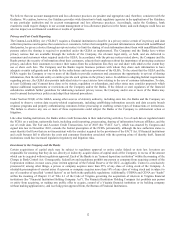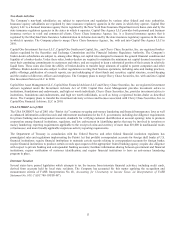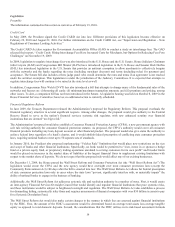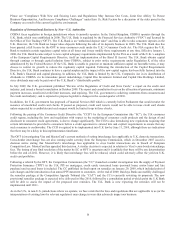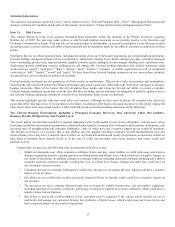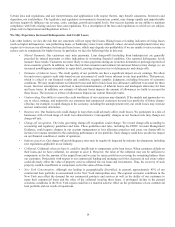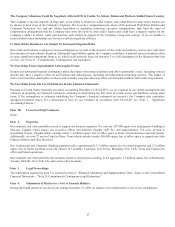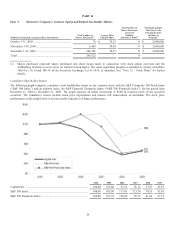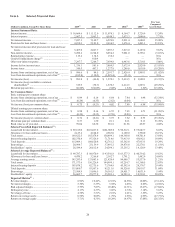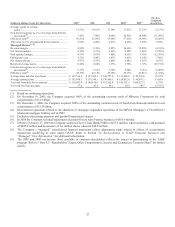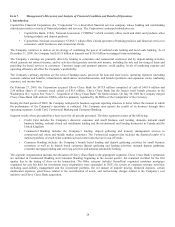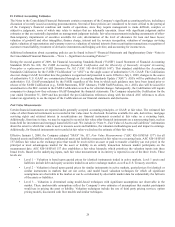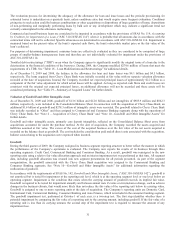Capital One 2009 Annual Report Download - page 34
Download and view the complete annual report
Please find page 34 of the 2009 Capital One annual report below. You can navigate through the pages in the report by either clicking on the pages listed below, or by using the keyword search tool below to find specific information within the annual report. 21
We Face Risk Related To The Strength Of Our Operational, Technological And Organizational Infrastructure
Our ability to grow and compete is dependent on our ability to build or acquire the necessary operational, technological and
organizational infrastructure. The Company is currently engaged in significant development projects to complete the systems
integration of Chevy Chase Bank and to build a scalable banking infrastructure. Implementation of such infrastructure changes and
upgrades may, at least temporarily, cause disruptions to our business, including, but not limited to, systems interruptions, transaction
processing errors, and system conversion delays, all of which could have a negative impact on our Company.
Similar to other large corporations, we are exposed to operational risk that can manifest itself in many ways, such as errors related to
failed or inadequate processes, faulty or disabled computer systems, fraud by employees or persons outside of the Company and
exposure to external events. In addition, we are heavily dependent on the strength and capability of our technology systems which we
use to manage our internal financial and other systems, interface with our customers and develop and implement effective marketing
campaigns. Our ability to develop and deliver new products that meet the needs of our existing customers and attract new ones and to
run our business in compliance with applicable laws and regulations depends on the functionality of our operational and technology
systems. Any disruptions or failures of our operational and technology systems, including those associated with improvements or
modifications to such systems, could cause us to be unable to market and manage our products and services and to report our financial
results in a timely and accurate manner, all of which could have a negative impact on our results of operations.
In some cases, we outsource the maintenance and development of our operational and technological functionality to third parties.
These third parties may experience errors or disruptions that could adversely impact us and over which we may have limited control.
Any increase in the amount of our infrastructure that we outsource to third parties may increase our exposure to these risks.
We May Fail To Realize All Of The Anticipated Benefits Of Our Mergers And Acquisitions
Capital One has engaged in merger and acquisition activity over the past several years. If we are not able to achieve the anticipated
benefits of such mergers and acquisitions, including cost savings and other synergies, our business could be negatively affected. In
addition, it is possible that the ongoing integration processes could result in the loss of key employees, errors or delays in systems
implementation, the disruption of each company’s ongoing businesses or inconsistencies in standards, controls, procedures and
policies that adversely affect our ability to maintain relationships with clients, customers, depositors and employees or to achieve the
anticipated benefits of the merger or acquisition. Integration efforts also may divert management attention and resources. These
integration matters may have an adverse effect on the Company during any transition period.
Our recent acquisitions also involve our entry into new businesses and new geographic or other markets which present risks resulting
from our relative inexperience in these new areas and/or these new businesses. These new businesses change the overall character of
our consolidated portfolio of businesses and could react differently to economic and other external factors. We face the risk that we
will not be successful in these new businesses and/or in these new markets.
We Face The Risk Of Fluctuations In Our Expenses And Other Costs That May Hurt Our Financial Results
Our expenses and other costs, such as operating, labor and marketing expenses, directly affect our earnings results. In light of the
extremely competitive environment in which we operate, and because the size and scale of many of our competitors provide them with
increased operational efficiencies, it is important that we are able to successfully manage our expenses. Many factors can influence the
amount of our expenses, as well as how quickly they may increase. Our on-going investments in infrastructure, which may be
necessary to maintain a competitive business, integrate newly-acquired businesses, and establish scalable operations, may increase our
expenses. In addition, as our business develops, changes or expands, additional expenses can arise as a result of a reevaluation of
business strategies, management of outsourced services, asset purchases, structural reorganization, compliance with new laws or
regulations or the integration of newly acquired businesses. If we are unable to successfully manage our expenses, our financial results
will be negatively affected.
The Soundness of Other Financial Institutions Could Adversely Affect Us
Our ability to engage in routine funding transactions could be adversely affected by the stability and actions of other financial services
institutions. Financial services institutions are interrelated as a result of trading, clearing, counterparty and other relationships. We
have exposure to many different industries and counterparties, and we routinely execute transactions with counterparties in the
financial services industry, including brokers and dealers, commercial banks, investment banks, mutual and hedge funds, and other
institutional clients, resulting in a significant credit concentration with respect to the financial services industry overall. As a result,
defaults by, or even rumors or questions about, one or more financial services institutions, or the financial services industry generally,
have led to market-wide liquidity problems and could lead to losses or defaults by us or by other institutions.



